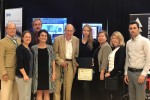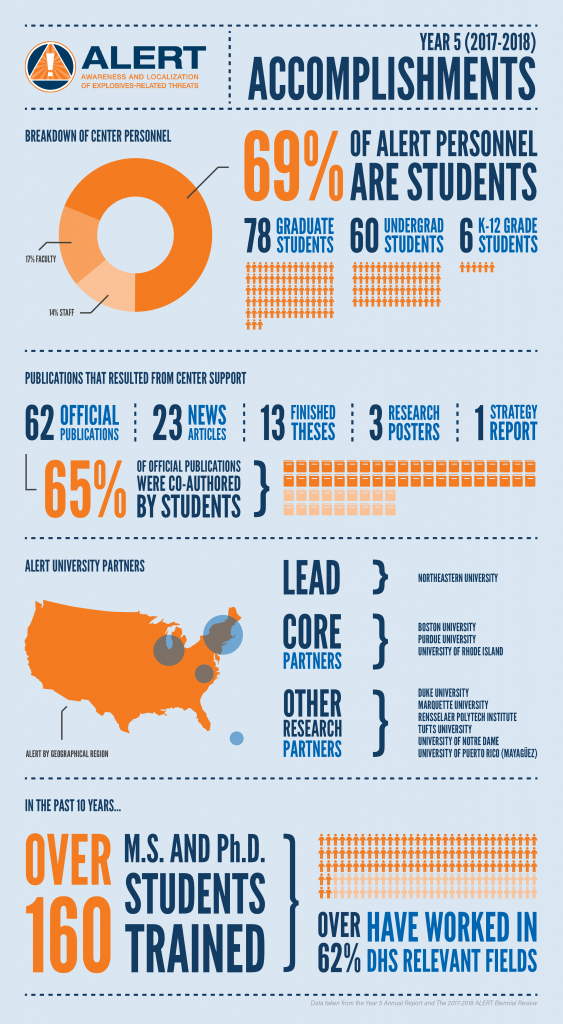News & Events
Research
Infographic: ALERT’s Year 5 (2017-2018) Accomplishments January 29, 2019
January 29, 2019
As we begin the New Year, we are also looking back on the previous year! Check out our newest infographic on ALERT’s Year 5 (2017-2018) Accomplishments.
ALERT Awarded Two New Task Orders November 29, 2018

Maturation and Validation of Dielectric Characterization Algorithms Task Order
ALERT has received a task order contract from the Department of Homeland Security (DHS) Science & Technology Directorate (S&T) to mature and operationalize the Advanced Imaging Technology material characterization (complex dielectric constant) algorithms being developed in ALERT Projects R3-A.2 and R3-B.1, led by ALERT Researchers, Dr. Carey Rappaport and Dr. Jose Martinez-Lorenzo of Northeastern University, respectively.
The task order, known as the “Maturation and Validation of Dielectric Characterization Algorithms,” will allow ALERT to use DHS owned images captured originally for the DHS S&T/TSA “Passenger Screening Algorithm Challenge.” The data for this prize competition was originally captured on the Apex Screening at Speed (SaS) High Definition – Advanced Imaging Technology (HD-AIT) laboratory prototype designed by Pacific Northwest National Lab. These images are available in several different file formats, including raw reflectivity formats. The data also includes ground truth information including relative body zone and materials for objects of interest. In the future, this data set may be augmented with additional images from future data collections. The end state for this development is an operationally functioning algorithm that is able to:
- Integrate with provided open file formats to add material characterization capabilities to existing Automatic Threat Recognition (ATR) algorithms;
- Demonstrate performance improvements (namely false alarm rate reduction while maintaining probability of detection) over current ATR algorithms;
- Run in near-real time, almost suitable for an operational environment; and
- Provide TSO-friendly output that will classify a foreign object into one of three categories (unlikely to be explosive, possible explosive threat, and undetermined).
Correlation of Luggage and Specific Passengers (CLASP) Algorithm Maturation and Deployment Task Order
ALERT has also received a DHS S&T task order contract, titled “Correlation of Luggage and Specific Passengers (CLASP) Algorithm Maturation and Deployment,” to mature algorithms developed under the ALERT CLASP Program so that the passenger-baggage tracking capability is sufficiently robust to support operational pilots and to support risk-based screening in an airport environment. DHS S&T has a variety of projects supporting the development of next-generation aviation security capabilities as a part of its Apex Screening at Speed (SaS) Program. Under the Apex SaS Program, passenger and carry-on screening requirements have necessitated adoption of a risk-based screening approach to the aviation checkpoint. In support of these risk-based screening requirements, the Apex SaS Program seeks to develop video analytics algorithms capable of associating passengers and their carry-on items as they travel through the airport checkpoint. Combined with existing TSA technologies, these algorithms will enable risk-based screening to occur on a per passenger and per item basis, improving screening efficiency and increasing overall passenger throughput. As a secondary benefit, effective video analytics will be able to identify thefts or items left behind at the checkpoint.
DHS S&T is seeking the following from the ALERT CLASP Algorithms project to further meet the needs of the Apex SaS Program:
- Algorithms capable of associating passengers and their carry-on items as they traverse the airport checkpoint that are robust to variations in lighting, passenger density, glare, camera angles, etc;
- Requirements and best practices for algorithm deployment in an operational environment (recommended hardware, configurations, etc.); and
- Algorithms capable of leveraging passenger/bag association information to identify actions at the checkpoint (such as interaction with scanning equipment, item theft, or items left behind).
ALERT Researchers Awarded Best Paper at 2018 ICDSC Conference September 27, 2018

September 27, 2018
Dr. Octavia Camps (Project R4-A.1; Northeastern University), Dr. Richard Radke (Project R4-A.3; Rensselaer Polytechnic Institute), and their research team received the Best Paper Award at the 2018 International Conference on Distributed Smart Cameras (ICDSC) in Eindhoven, Netherlands on September 3-4, 2018.
The paper, titled “Correlating Belongings with Passengers in a Simulated Airport Security Checkpoint,” is co-authored by Ashraful Islam, Yuexi Zhang, Dong Yin, Octavia Camps and Richard Radke. The research for this paper was done using data collected for CLASP (Correlating Luggage and Specific Passengers) project at ALERT’s Video Analytics Lab located at the Kostas Research Institute for Homeland Security at Northeastern University.
According to the paper’s abstract, “Automatic algorithms for tracking and associating passengers and their divested objects at an airport security screening checkpoint would have great potential for improving checkpoint efficiency, including flow analysis, theft detection, line-of-sight maintenance, and risk-based screening. In this paper, we present algorithms for these tracking and association problems and demonstrate their effectiveness in a full-scale physical simulation of an airport security screening checkpoint. Our algorithms leverage both hand-crafted and deep-learning-based approaches for passenger and bin tracking, and are able to accurately track and associate objects through a ceiling-mounted multi-camera array. We validate our algorithm on ground-truthed datasets collected at the simulated checkpoint that reflect natural passenger behavior, achieving high rates of passenger/object/transfer event detection while maintaining low false alarm and mismatch rates.”
Click here to read the paper and learn more about this research.
ALERT Leads Trace Detection Seminar for Industrial Partner September 27, 2018

September 27, 2018
ALERT Thrust R2 Lead, Dr. Steve Beaudoin (Purdue University) led a seminar on Trace Detection at Rapiscan Systems, an OSI Systems Company, in Andover, Massachusetts on August 17, 2018. Rapiscan Systems, an ALERT Industrial Partner, specializes in providing state-of-the-art products, solutions, and services to meet the threat detection needs at airports, border crossings, railway stations, government and military installations, and high-risk facilities around the world.
Under the ALERT Industrial Partnership model, Industrial Partners can select one or more ways to allocate their membership fees. One of those options is a full-day seminar on a topic of the Industrial Partner’s choice and relevant to one of ALERT’s four research thrusts.
Dr. Beaudoin spent the morning with about 15-20 Rapiscan employees, interns, and co-op students from several disciplines. During this time, he gave a 2-hour (10:00am-12:00pm) lecture style presentation on Trace Detection covering three topics of interest: particulate explosives, compound explosives, and the TESSA Project – Contact Sampling Study. Participants had the opportunity to ask questions during the presentation, and after lunch, there were several more hours of Q&A and discussion (ending at 4:00pm). Several collaboration opportunities were discussed throughout the day, as well as several ways in which the two organizations can support one another’s work.
The feedback throughout the day, from several Rapiscan employees, was very positive and was followed by a request for more seminars in the future. Dr. Beaudoin’s contact sampling project report and seminar presentation was disseminated to the Rapiscan team as a resource.
According to Stefan Lukow, Ph.D., Director of Research and Development at Rapiscan Systems, “The seminar last Friday was very well received by many members of my R&D group as well as the greater engineering team. Throughout Steve’s presentation, there were many discussions and also ideas spurred for potential collaboration or suggestions for future work to be done by either side. It was informative and took the tone of a discussion rather than a lecture. Following the presentations, Steve made himself available for additional discussion with the engineering team for more in-depth discussions and several took him up on this offer. Overall, it was greatly beneficial to have Steve present his work and that of the ALERT center. I hope for more opportunities in the near future.”
For more information about ALERT’s customizable Industrial Partnerships and benefits of partnering with ALERT, please visit the ALERT Website or email Emel Bulat (Industrial and Government Liaison Officer) or Kristy Provinzano (Industry Liaison Associate).
Photo caption: Low-resolution scanning electron microscope image of freestanding micro-patterned traps used during contact sampling
Summer 2018 REU Program July 31, 2018

July 31, 2018
This summer, ALERT is hosting seven undergraduate students who are participating in the 10-week long Research Experiences for Undergraduates (REU) program. At Northeastern University, two students are working with Professor Carey Rappaport (Project R3-A.2, Project R3-A.3), and three students are working with Professor Jose Martinez Lorenzo (Project R3-B.1, Project R3-B.2). ALERT is also hosting two students at the University of Puerto Rico Mayagüez who are doing research with Professor Samuel Hernandez (Project R3-C), and one student at Duke University who is working with Professor Joel Greenberg (Project R1-C.3).
The ALERT REU Program at Northeastern University collaborates with other REU programs in the College of Engineering to build a cohort of students who jointly attend professional development meetings and program activities. At the end of the summer, each REU creates a research poster and presents a final presentation on their research project. These deliverables address the project’s overall mission and endeavors, the REU’s specific contributions to the project, as well as the knowledge and skills they gained from the experience.
If you are interested in hearing more about the experiences of past REU students, please check out our short video: “ALERT Undergraduate Research in the AIT Lab at Northeastern University.”
Caption: REU students, Diego Rojas and Alexis Costales, conduct research in Professor Jose Martinez Lorenzo’s laboratory at Northeastern University.
2018 DHS COE Summit Facilitates Collaboration and Advances DHS Mission July 31, 2018

ALERT, along with other current and emeritus DHS Centers of Excellence (COEs), hosted the 2018 Centers of Excellence Summit in Arlington, Virginia on May 30-31, 2018. The event focused on the topic of “University Research and Development to Protect the Homeland.” The DHS COE Summit provided the Centers of Excellence an opportunity to showcase their innovative solutions to homeland security challenges and facilitate collaboration across homeland security enterprise leadership and component end-users and industry participants. According to ALERT Center Director, Michael B. Silevitch,
“One of the most valuable aspects of the Summit was the teamwork needed to pull it together. It required a concerted effort by all of the COEs to organize and orchestrate the event. Going forward, this teamwork will lead to meaningful cross-center collaboration.”
The agenda for the two-day long summit was launched with a keynote address from Christopher C. Krebs, Senior Official Performing the Duties of Under Secretary, National Protection and Programs Directorate (NPPD) and included talks by various security administrators, panel discussions, student posters, and a technology showcase.
Director Silevitch moderated a panel focused on “Transportation and Critical Infrastructure” on the first day of the summit. Panelists Carl Crawford, Eva Lee, David Nicol, and Detlof VonWinterfeldt addressed four questions related to this topic:
- What are some of the grand challenges that need to be addressed to enable the next generation of Homeland Security transportation and critical infrastructure solutions?
- What research needs to be done in order to address these challenges?
- How can the research outcomes be effectively transitioned to the field?
- What metrics can be used to enable a cost-benefit analysis of the research/transition impact?
ALERT’s Transition Team made connections with end users at the technology showcase and featured some of ALERT’s latest solutions in multi-view air cargo CT scanners, effective personnel screening, video tracking at the airport security checkpoint, and K9 explosives training aids.
COEs excel in advancing the state of the art thanks in large part to their student researchers. To acknowledge this, the summit provided students with the opportunity to present their work to attendees. Katherine Graham, one of ALERT’s talented undergraduate researchers, took home the Best Poster Award for her work on “Compressive Reflector Antennas for High-Sensing Capacity Imaging Applications.” These antenna designs provide a less complex and lower cost solution for high-sensing capacity millimeter wave imaging systems. Millimeter wave imaging systems have the potential for use in several near-field imaging applications such as security screening, non-destructive testing, autonomous driving, and biotechnology. The abstracts for the COE Summit student posters are available for download on the COE Summit 2018 website.
The summit provided an all-hands-on-deck approach to addressing homeland security challenges by bringing together some of the nation’s best academic, public, and private sector leaders to discuss strategies for advancing the mission of the Department of Homeland Security. ALERT looks forward to the next DHS COE Summit, and hopes you will join us there!
ALERT Launches New Workshop Series July 31, 2018

July 31, 2018
The first Advanced Development for Security Applications for Customs and Border Protection (ADSA-CBP-01) Workshop occurred on June 20-21, 2018 at Northeastern University in Boston, MA. This workshop, an offshoot of the original ALERT ADSA Workshop series, brought together 120 attendees from government, industry, and academia to discuss key problem areas in port security, as well as current technology and potential improvements; brainstorm the future state of cargo security; and identify future technology concepts.
The ADSA-CBP-01 Workshop addressed problem solving for the following venues, threats, and stakeholders:
- Ports of entry: mail, parcel, airports, ships, rails, and land crossing
- Transportation: aircraft, rail, cars, trucks, ships, and pedestrians
- Threats: persons and/or contraband (narcotics, agriculture products and intellectual property)
- Stakeholders: DHS-CBP, industry, academia, and national labs
Presentations were given in the following areas of expertise:
- Scanning technologies
- Concepts of operation
- Deterrence and hardening
- Financial and policy implications
If you were unable to attend the ADSA-CBP-01 Workshop, presentations from the two-day event are available for download.
The ADSA-CBP-01 Workshop is convened by the Department of Homeland Security (DHS) Center of Excellence (COE) for Awareness and Localization of Explosives-Related Threats (ALERT) at Northeastern University. ALERT is supported by the DHS Science and Technology Directorate and the Customs and Borders Protection Office of Field Operations through the DHS Office of University Programs.
The next installment of this workshop series, ADSA-CBP-02, is planned for March 2019. These workshops are by invitation only; however, if you are interested in attending, please inquire with ALERT at [email protected].
Presentations from Spring/Summer Workshops and Program Reviews Available Online July 20, 2018
July 20, 2018
We are pleased to announce that the presentations from the Eighteenth Advanced Development for Security Applications Workshop (ADSA18) held on May 15-16, 2018 and the First Advanced Development for Security Applications for Customs and Border Protection Workshop (ADSA-CBP-01) held on June 20-21, 2018 are now available online at the following links:
- ADSA18 Workshop Presentations: https://alert.northeastern.edu/transitioning-technology/adsa/final-reports-and-presentations/adsa18-presentations/
- ADSA-CBP-01 Workshop Presentations: https://alert.northeastern.edu/transitioning-technology/cbpadept/adept-final-presentations/adept-01-presentations/
The presentations from the recent CLASP & AATR Program Reviews (May 17, 2018) are also available online at the following links:
- CLASP Program Review Presentations: https://alert.northeastern.edu/transitioning-technology/clasp-aatr-program-reviews/clasp-presentations/
- AATR (Task Order 07) Program Review Presentations: https://alert.northeastern.edu/task-order-07/
If you have any questions regarding the topics and technologies discussed at these events, please contact ALERT at [email protected].
ALERT Research Highlight: The Largest and Most Systematic Re-id Benchmark to Date May 30, 2018

May 30, 2018
ALERT researchers Professor Octavia Camps (Northeastern University, Project R4-A.1) and Professor Rich Radke (Rensselaer Polytechnic Institute, Project R4-A.3) and their students, Srikrishna Karanam, Mengran Gou, Ziyan Wu, and Angels Rates-Borras, were recently published in the Institute of Electrical and Electronics Engineers’ (IEEE) monthly journal, Transactions on Pattern Analysis and Machine Intelligence (download here). The paper, “A Systematic Evaluation and Benchmark for Person Re-Identification: Features, Metrics, and Datasets,” provides an extensive review and performance evaluation of existing person re-identification algorithms.
Person identification, or re-id, matches observations of individuals across multiple camera views in a network of surveillance cameras, and represents a critical task in most surveillance and security applications. For example, a law enforcement officer may want to automatically follow a person of interest tagged at a check-in counter through the branching concourses of an airport. The research team’s recent review and evaluation of re-id algorithms helps characterize what re-id algorithms are currently capable of accomplishing, as well as what is missing and what is possible in the future. In this paper, the researchers discuss insights gained from their study, as well as put forth research directions and recommendations for re-id researchers that would help develop better algorithms in the future. Both Professor Camps and Professor Radke are involved with ALERT’s Research Thrust 4, which focuses on video surveillance and the analysis of video data with novel algorithms. This publication was the result of years of research and collaboration between their respective labs.
The fundamental re-id problem is to compare a person of interest as seen in a “probe” camera view to a “gallery” of candidates captured from a camera that does not overlap with the probe camera. If a true match to the probe exists in the gallery, it should have a high matching score, or rank, compared to incorrect candidates. Since the body of research in re-id is increasing, researchers can begin to draw conclusions about the best combinations of algorithmic subcomponents. In this paper, the researchers present a careful, fair, and systematic evaluation of feature extraction, metric learning, and multi-shot ranking algorithms proposed for re-id on a wide variety of benchmark datasets. Their general evaluation framework considers hundreds of combinations of feature extraction and metric learning algorithms for single-shot and multi-shot datasets.
The research team evaluated 276 algorithm combinations on 10 single-shot re-id datasets and 646 algorithm combinations on 7 multi-shot re-id datasets, making the proposed study the largest and most systematic re-id benchmark to date. Approaches were evaluated using 17 datasets that mimic real world settings, including the ALERT Airport Re-Identification Dataset. As part of the evaluation, the researchers built a public code library with an easy-to-use input/output code structure and uniform algorithm parameters that includes 11 contemporary feature extraction and 22 metric learning and ranking algorithms. Both the code library and the complete benchmark results are publicly available for community use.
Time is running out! May 17, 2018

COE Summit Registration Deadline is THIS FRIDAY, May 18th
U.S. Department of Homeland Security Centers of Excellence Summit 2018: University Research & Development to Protect the Homeland
Summit Dates: May 30-31, 2018
Location: George Mason University, 3351 Fairfax Drive, Arlington, VA
The deadline to register for the 2018 Centers of Excellence (COE) Summit is this Friday, May 18th. Don’t miss this interactive event which brings together researchers, DHS components, industry and first responders to discuss next-generation technology and tools developed to solve homeland security challenges.
This year’s summit features keynotes and discussions with top leaders in homeland security, including:
- Christopher Krebs, Senior Official Performing the Duties of Under Secretary,NPPD
- Corey Gruber, Deputy Associate Administrator, Office of Response and Recovery, FEMA
- Darby LaJoye, Assistant Administrator, Office of Security Operations, TSA
- Kevin McAleenan, Commissioner, CBP
- Matthew Allen, Assistant Director, Investigative Programs Homeland Security Investigations, ICE
- William (Bill) Bryan, Senior Official Performing the Duties of the Under Secretary for Science and Technology, DHS S&T
- Anneli Bergholm Soder, Head of the Operations, Department of the Swedish Civil Contingencies Agency
- Daniel Kaniewski, Deputy Administrator for Protection and National Preparedness, Federal Emergency Management Agency
The COE Summit’s Full Agenda also includes panel sessions on homeland security topics, an innovation showcase and student posters session.
Register HERE by May 18, 2018.
The COE Summit is sponsored by the United States Department of Homeland Security Centers of Excellence (COEs). The COE network is a consortium of hundreds of universities that conduct research and education to address homeland security challenges. ALERT is one of nine current Centers of Excellence sponsored by the Department of Homeland Security Office of University Programs.

